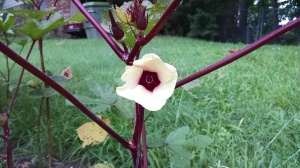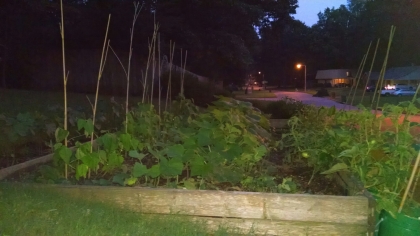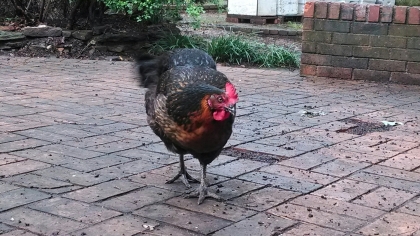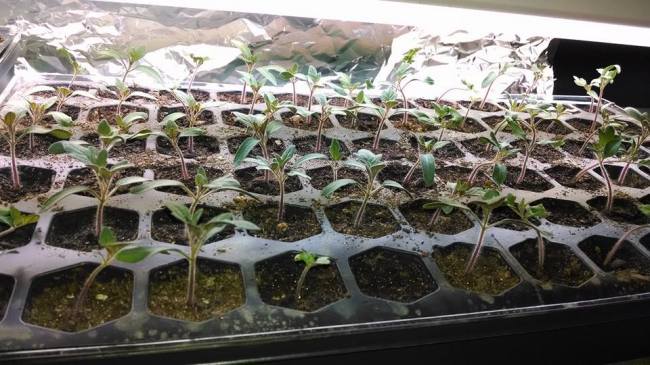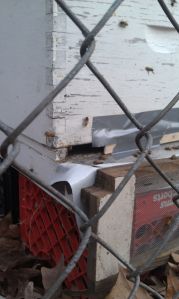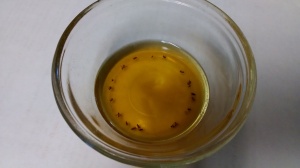 The more fresh fruit and vegetables we eat, the more fruit flies we have to contend with. They piggyback on grocery store fruit and multiply like crazy once they get to the house. In years past they were overwhelming. They’d not only swarm fruit sitting out on the kitchen counters, but also around the garbage can, compost containers, and sink.
The more fresh fruit and vegetables we eat, the more fruit flies we have to contend with. They piggyback on grocery store fruit and multiply like crazy once they get to the house. In years past they were overwhelming. They’d not only swarm fruit sitting out on the kitchen counters, but also around the garbage can, compost containers, and sink.
I found this little tip that works wonders for keeping them under control, and as I prepared this week’s batch, I thought I should share it with you. Simply take a small, shallow bowl (these Pyrex bowls work well, but ramekins work well, too) and pour in a half-inch or so of apple cider or red wine vinegar. Then take a drop – really, just a drop – of dishwashing liquid like Dawn in the vinegar. Place the bowl next to an area where you’ve noticed a lot of fruit flies. I’ll typically place mine next to the garbage can or close to a bowl of fruit. That’s it! As you can see by the picture above, this works great.
The mechanism, if you’re interested, is that the fruity vinegar attracts the flies and the dishwashing liquid breaks the surface tension of the vinegar so that rather than floating on top of the liquid, the fruit flies sink. They aren’t poisoned, they’re drowned.
I hope this little tip helps you like it has me. If you have any tips like this, please share!
I took a few days and traveled to East Tennessee over the weekend for a wedding. It was gorgeous there, beautiful cool weather, perfect for some lake time. Meanwhile, unbeknownst to me, Memphis was under a deluge: rain thunderstorms, flash-floods, the works. I arrived home wondering what the house, rabbits, chickens and plants would look like on my return. Imagine my (pleasant) surprise to find everything lush, green, and blooming.
You may complain about the rain this year, but don’t be surprised if I suddenly punch you in the throat. My garden, and beautiful, thick sunflower, corn and soybean fields across the state would argue that this year, finally, Memphis has had some perfect weather.
Hermione is the newest addition to our little backyard “farm”. She came to us via a friend and fellow urban agriculturist who was having trouble with her vocalizing her opinion, so to speak. She was clucking so loudly, and so early, that it was waking both him and his neighbors. Since I’m the closest thing to a butcher most of my friends know, I usually get their problem animals. Such was the case with Hermione. But it turns out that she rather likes it here. She’s quiet unless the dogs spook her. She wanders the yard pecking and scratching and has laid a couple of eggs for us.
So – for now – she stays.
If you’re connected to this blog, then like me, you probably like fresh, great-tasting food, gardening, nutrition, and the (natural) science of where your food comes from. Part of the reason I blog is to keep a running journal of what I’m doing, but also to let people know how easy it is to grow your own food, especially in a small space. We need to spread the word!
So in the spread-the-word department, a couple of things that might be of interest to you.
First, I’ve found that a great way to get people started gardening is to lower the barriers of entry. One of those barriers is knowing what kind of plants to buy, where to buy them, and how to get them cheaply. So many people just don’t know what to buy, and they’re intimidated by their lack of knowledge and the price of good plants at their local big box hardware store. To the rescue! This is now the third year I’ve had a plant giveaway at my church. Yesterday I gave away close to 80 tomato and pepper plants. I start the seedlings for myself each year, and honestly it’s so cheap and easy to do that there’s no reason not to produce a surplus. For each of the last three years I’ve added to the number of seedlings I’ve planted. I pick what I want for myself then take boxes of plants to church with a “Please Take Me Home” sign taped on. People are thrilled to get them, even folks who have never gardened before, and it opens up all kinds of opportunities for conversation. I get to tell them why I plant heirlooms, the organic methods I use, what kind of care their plants need at home, etc. If you’re handy with seed-saving or seed-planting, let me encourage you to plant for surplus, and give away as many as you can.
Second, over the weekend I received an unsolicited email with a link to a great infographic about micro-farming. I love infographics. It saves me from having to do any serious reading <grin>. But seriously, give it a look at http://www.superscholar.org/backyard-micro-farming/, and share it with your friends. Oh – and do the reading. If you scroll below the (long) graphic, there’s some good background to the numbers and concepts.
Filed under: Bee Keeping | Tags: beekeeping, Bees, Honey, Honey Production
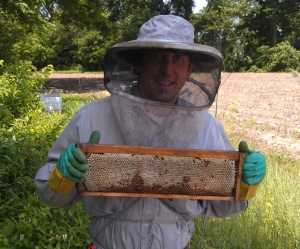 Last week’s post in my Bee Keeping 101 series was a reminder that if you’re ordering packages, now (January) is the time to do it. It was also the very first post of the series.
Last week’s post in my Bee Keeping 101 series was a reminder that if you’re ordering packages, now (January) is the time to do it. It was also the very first post of the series.
It seems I may need to back up a bit.
I had a series of comments with a reader, leading to a great dialogue, about why I would advocate ordering packaged bees (~$80-$90) when folks could just catch free swarms. From there we delved into what is today’s topic; Why do you want to keep bees in the first place?
I am now the third in four generations of bee keepers. My grandfather kept bees for honey. I remember visiting both his house and farm and seeing hives towering over my head, stacked tall with honey supers. I remember the shelves in my grandmother’s pantry lined with quart jars full of honey. And always when we would visit, they would send a jar home. It was beautiful, golden, and packed with sealed, white comb. I started keeping bees because it’s in my blood, and because I love honey. Once folks find out that I sell honey, they start asking questions to find out if it’s a money maker. In fact, most people I meet think that the reason you raise bees is to make money on honey. There is no money in honey. Actually, I make enough to put back in the business for needed replacement supplies each year.
Other folks, like Solarbeez are concerned about the plight of bees (you’ve been hiding in a hole if you don’t know how much trouble bee colonies are in these days) and are doing their best to make increase the natural bee population by collecting and propagating swarms using natural bee keeping methods, and using fewer “modern” industrial techniques for housing and caring for bees. (Check out Solarbeez incredible log hives!)
Being in the gardening/farming community, I also meet lots of folks who want bees simply to pollinate their crops. They set up hives in their yards and gardens, or along crop rows to increase fruit production.
Here are a few things I’ve discovered based on what I’ve observed from these different groups: your method of bee keeping often depends on your goals in bee keeping. But also, rarely does a bee keeper fall firmly into only one of these categories. In fact, often a well educated bee keeper can’t help but nod his head in agreement when he/she understands the arguments.
Hopefully we’ll have time to discuss this further, but here a few more notes: If honey is not your primary reason for tending bees, then consider making your own equipment, especially top bar hives. They have a very basic design and can be easily assembled from scavenged scrap wood. They’re easy to throw a swarm or a package of bees in, but more difficult to transition from a nuc. You can find lots of very complicated plans on the web, but really all you need to see is the basic structure to kick your imagination in high gear. Here are some plans to get you going. If you’re into honey production, then a Langstroth hive is probably the way to go. It has become the de facto standard for honey production. It’s easy to build up a honey-making factory, and it’s convenient for swapping parts with other hives and other bee keepers. But they’re considerably more expensive and more complicated to build from scratch. I usually buy my Langstroth parts from Brushy Mountain. You can buy a complete kit from them here.
After many years of bee keeping, I find myself squarely in the “all three categories” camp. I really want honey. I really want the bees to pollinate my crops. But I do everything I can to promote natural bee health, including open breeding, no pesticides, swarm catching, and certainly – though accidentally – swarm releasing.
If you’re already a bee keeper, you’ll get that joke.
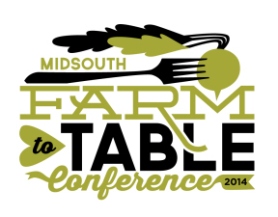 I wanted to take a quick minute to give a shout out for this year’s Farm to Table conference on February 4 in Memphis. I missed it last year, but attended the first two years. I learned a ton of great information that ranged from growing melons to selling in farmer’s markets. It’s also a great way to connect with like minded foodies, farmers, and policy makers.
I wanted to take a quick minute to give a shout out for this year’s Farm to Table conference on February 4 in Memphis. I missed it last year, but attended the first two years. I learned a ton of great information that ranged from growing melons to selling in farmer’s markets. It’s also a great way to connect with like minded foodies, farmers, and policy makers.
You can get more info here at their web site (which, admittedly, is still a bit sparse).
See you there!
I’ve had several folks ask this year if I’d help them get started in bee keeping. I’ve been keeping bees for 15 or 16 years now, so I guess that makes me “experienced” enough to give out a bit of advice. So here’s your first bit of advice here on January 3; time to order bees.
I know it’s freezing right now. Heck, it’ll be 16 in Memphis next week, with a low of 9. The bees aren’t doing anything except huddling together in their hive trying to keep each other warm. But in just three short months (in Memphis), the temps will regularly inch up to more than 55 degrees, and the bees will start flying, looking for forage. By early April there will be a steady honey flow due to the mass of flowering plants here in the south, and you want to have your hives well established in order to take advantage of the flow.
WARNING: If you wait until March or April to order your bees, you’ll be flat out of luck.
Established bee keepers know that there’s a fixed number of bees at any specific time (after all, they’re living creatures that must be bred), and coming out of winter, the numbers are generally low. First come, first served is the name of the game this time of year.
So step number one that you should be thinking about right now is ordering either packages or nucs (nucleus hive), preferably from a local bee keeper (we’ll talk about why that’s important in another post).
If I were just starting out, I’d check with my local extension office for a bee keeping association. Hook up with the guys/girls in the group and find out who they order from, or whether any of the members would be willing to sell you a nuc. You can find a goldmine of information and make some terrific connections through your local bee keepers’ association.
No rest for the weary backyard farmer. While you’re sitting inside enjoying your hot chocolate, start looking for bee breeders!
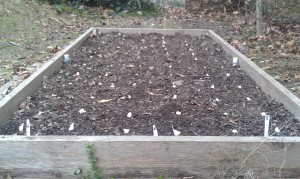 Better late than never? I hope so. I’m only today getting my garlic planted. We’ve got a warm spell this week, so the weather is nice enough to get some things done.
Better late than never? I hope so. I’m only today getting my garlic planted. We’ve got a warm spell this week, so the weather is nice enough to get some things done.
This year’s plot is a little different than last year’s. I planted another 60 cloves (like last year). But if you notice the picture above, I have markers placed for divided sections of twenty cloves each. Last year I bought a big bag of garlic from Costco, divided the cloves, and planted. This year, I bought another bag, but I also bought a small bag of organic garlic, and took three heads of garlic that I grew last year, and divided those. So, I have three different types of garlic planted, to compare with each other. I’ve marked them above with “O” for organic, “S” for Scott garlic, and “R” for regular, or conventional, store-bought garlic. Eventually, I’d like to only grow garlic that I’ve cultivated, but we just didn’t have enough left from last year’s crop to plant a full bed. Read that last statement carefully; we probably pulled in 55 heads of garlic of the 60 we planted. But just like a raise in your paycheck, any extra you have gets consumed quickly. We have burned through an enormous amount of garlic since July when we harvested.
For those of you who haven’t planted garlic before, you should. It’s incredibly easy, and it’s so rewarding to have long braids of fresh garlic hanging in your kitchen, ready to pull anytime you need to add a little spice to a meal.
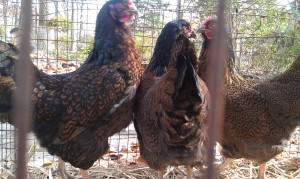 It’s been a weird weekend, a weekend of expected and unexpected death and dismemberment.
It’s been a weird weekend, a weekend of expected and unexpected death and dismemberment.
It was butchering day yesterday for my three remaining rabbits. Two weeks ago a pack of dogs came in the yard in the dead of night through an opened gate to destroy one of my rabbit cages and kill two rabbits. Of the three who were left, one got a stay of execution at the ninth hour. A friend called and offered to trade a rabbit for three non-laying hens. He’s a vegetarian but didn’t want to keep buying chicken feed for three girls who were well past their prime (they were 2-3 years old). He also knows the value of rabbit manure, so he was willing to offer what – to me – was a pretty good trade. He brought over three of the most gorgeous chickens I’ve ever seen. I threw together a pen in the back yard out of pallets I had laying around and put them in while I got to work butchering the boys.
It was dark by the time I got the two rabbits “dispatched”. They ended up at 3.04 and 3.05 lbs each, which is in line with last year’s batch of rabbits. They should be good for stew and as a chicken replacement in casseroles.
Afterwards, we rounded up the three chickens and put them in their pen, along with some water and food. We then covered the pen with a tarp we had been using to cover the rabbit pen. It was going to be 27 degrees, so we wanted to make sure they were well covered.
This morning was still cold, and because it was Sunday, we got up early and headed to church. After worship ended, my wife and I headed home quickly to get Sunday dinner completed before the rest of the family got home. But before I even went in the house, I went to let the chickens out of their crowded cage.
I grabbed a bowl of food, filled up a waterer, and pried open the makeshift pen. I threw the tarp up to find: horror. There was a mass of blood and feathers, bare skin and hard, stiff bodies. The chickens were dead.
I’ve cleaned up the mess, bagged the chickens (kept the feathers for compost), and thought about this event the rest of the afternoon. I’m sad at the waste of life – both the chickens’, and the life they would provide my family through their meat. I’m confused at what happened. All I can think of is that the three went into a pecking frenzy in their cramped cage. Judging by the amount of damage observed on each one, I think that there might have one left standing who then froze without the warmth of her sisters.
I don’t get too disappointed or disgusted by these tragedies any more. Dogs eat rabbits. Chickens peck other chickens, sometimes ruthlessly. It’s who they are. I find, however, that I get a little mad at the waste and my inability to see events like this coming. But shame on me if I don’t learn from the mistakes, huh?

